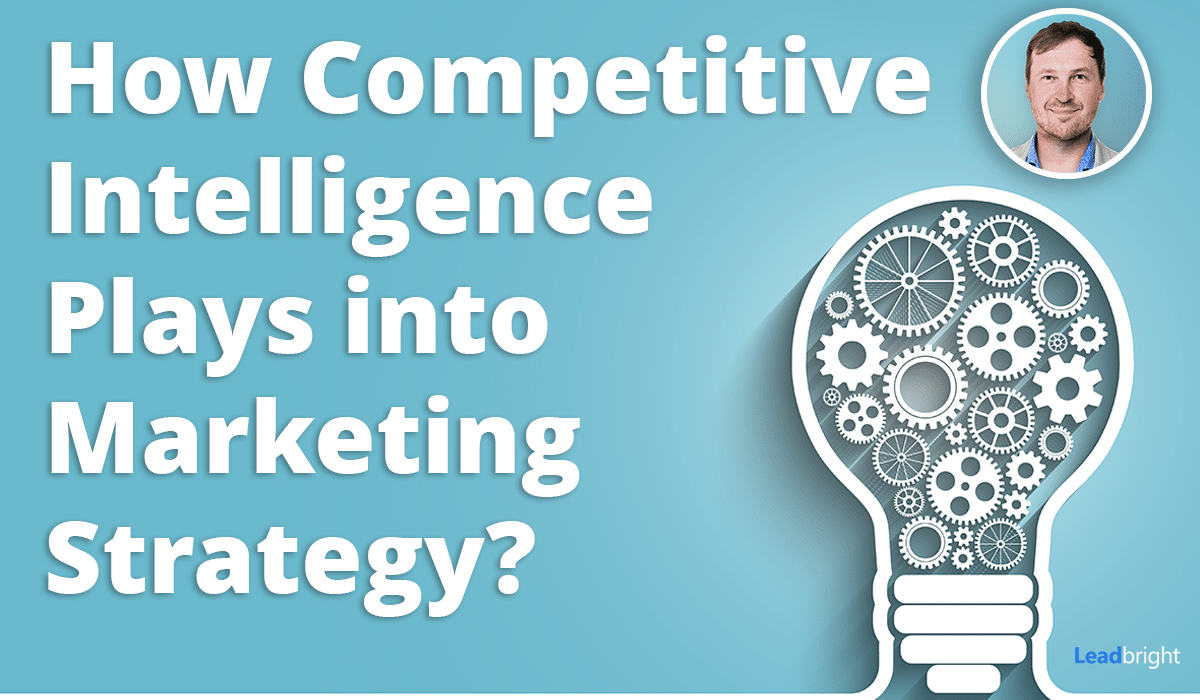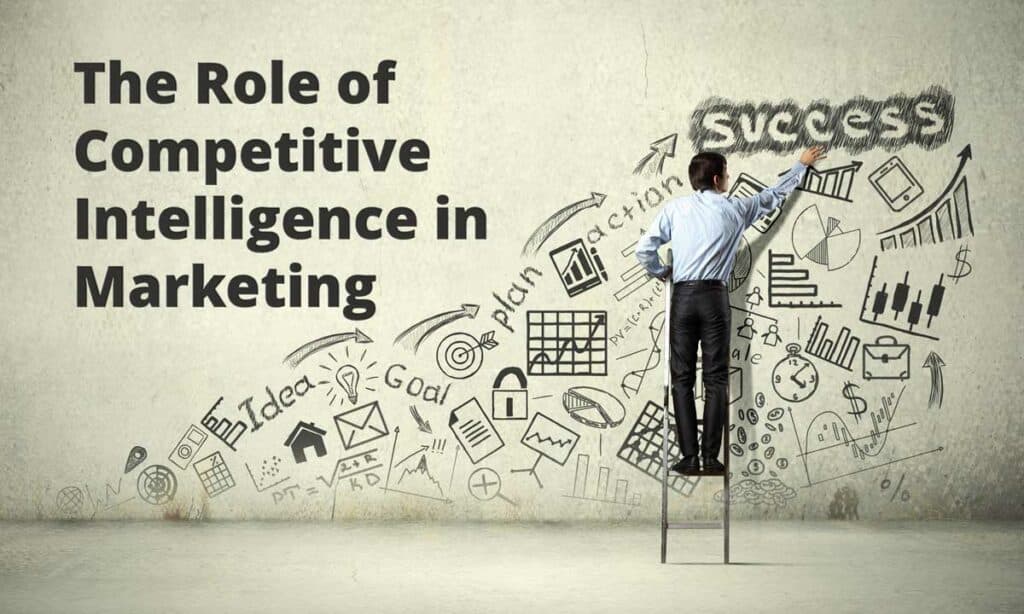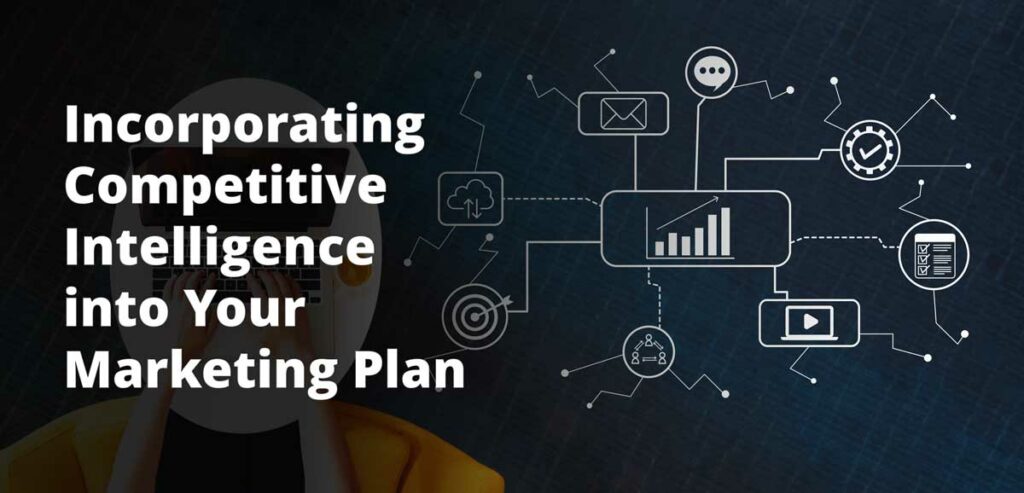How Competitive Intelligence Plays into Your Overall Marketing Strategy

Common pitfalls are highlighted to inform best practice approaches.
Lastly, future trends in this area are considered to provide insights into evolving market dynamics.
Key Takeaways
- Competitive intelligence is the process of gathering, analyzing, and utilizing information about competitors in strategic decision-making.
- Analyzing competitor strategies provides insights into market trends and potential opportunities for differentiation.
- Competitive intelligence enhances strategic decision-making and informs marketing approaches.
- Adherence to intelligence ethics ensures responsible and legal use of data.
Understanding the Concept of Competitive Intelligence
In the realm of business strategy, competitive intelligence is a crucial element that warrants thorough scrutiny. To fully grasp its importance, it becomes necessary to define this concept and understand its various aspects first clearly.
Furthermore, delving into the profound significance of competitive intelligence not only in sustaining businesses but also in driving their growth will provide valuable insights into its indispensable role.
Defining Competitive Intelligence
Competitive intelligence refers to the process of gathering, analyzing, and utilizing information about competitors in strategic decision-making. It involves Intelligence Ethics, ensuring that this data is obtained legally and ethically.
Competitive Landscape provides a comprehensive view of the market, allowing for more informed decisions. Various Intelligence Sources are employed, such as databases or industry reports, but they come with Intelligence Limitations like outdated or incomplete data.
Despite these limitations, the insights gained from competitive intelligence can aid in Competitive Forecasting by predicting future trends based on current patterns within the competitive landscape. Thus, it is essential to understand how these components interact to effectively utilize competitive intelligence in marketing strategies.
Importance of Competitive Intelligence
Understanding the significance of gaining insights into rival businesses and market trends can greatly enhance strategic decision-making in any industry.
Intelligence sources provide valuable information, yet intelligence limitations must be acknowledged to avoid missteps in strategy implementation.
Market predictions are an essential aspect of competitive intelligence, aiding organizations in anticipating potential business scenarios.
However, utilizing such information necessitates adherence to Intelligence Ethics which stipulate that data should only be used responsibly and legally to maintain a competitive edge.
These factors underscore the importance of competitive intelligence, positioning it as a vital resource for informed decision-making processes.
The ensuing discussion will delve deeper into this topic by exploring the role of competitive intelligence in marketing.
The Role of Competitive Intelligence in Marketing

The subsequent discourse will delve into the cruciality of understanding competitor strategies in the context of competitive intelligence within marketing.
It is posited that an in-depth awareness of rivals’ tactics enables a firm to not only anticipate market shifts but also to adjust its methods accordingly for optimal impact.
Furthermore, the discussion will elucidate how leveraging insights gleaned from comprehensive market analysis can provide a significant advantage, allowing businesses to adapt swiftly and effectively to any changes or opportunities that may emerge.
Understanding Competitor Strategies
Analyzing competitor strategies provides valuable insights into market trends, consumer preferences, and potential opportunities for differentiation. A comprehensive Strategy Comparison entails a detailed examination of each competitor’s approach to the market, while Competitor Profiling offers an in-depth understanding of their strengths, weaknesses, and unique selling propositions.
The analysis involves scrutinizing their Market Positioning and Pricing Strategies to determine how they target various customer segments and price points. Further exploration of Brand Differentiation illuminates how competitors establish distinct identities in the marketplace. This process aids in identifying gaps in the market that can be exploited for competitive advantage.
These findings subsequently form a crucial foundation for leveraging market insights in order to enhance marketing strategies further.
Leveraging Market Insights
Leveraging market insights, derived from the examination of competitor strategies, offers the potential for creating enhanced marketing approaches and capturing untapped opportunities in various customer segments.
Insight driven campaigns aid in this process by using these insights to inform strategy and tactics. Market trends analysis further supports this approach, providing a more comprehensive view of customer needs and preferences.
The utilization of predictive intelligence plays a pivotal role here; it aids in forecasting future market trends based on current data patterns. Gaining customer behavior insights becomes crucial as well, allowing businesses to understand their target audience better and tailor their offerings accordingly.
Tools and Techniques for Gathering Competitive Intelligence
Various tools and techniques are employed in the process of gathering competitive intelligence, each contributing to a comprehensive understanding of the market landscape. Intelligence outsourcing is often used as a method to gather external data from experts who specialize in this field. This can save resources and provide valuable insights that may not be available internally.
Social media scouting is another technique frequently utilized due to its vast reach and rapid dissemination of information. By observing online conversations, trends and consumer sentiment towards competitors’ products or services can be analyzed, providing real-time insights into market dynamics.
Patent research also plays an instrumental role in competitive intelligence collection. It provides information about competitors’ inventions, technological advancements, and future business strategies. Not only does it reveal what rivals are currently working on but also where they might be heading in terms of innovation.
Collaboration benefits are evident when multiple departments within an organization work together to collect and interpret competitive intelligence. The collective efforts result in a broader perspective of the competitive landscape, enabling more informed strategic decision-making processes.
Lastly, cross-industry comparisons offer unique insights by evaluating practices outside the immediate competition circle. These comparisons can uncover innovative approaches, strategies or technologies that could potentially redefine market norms within one’s own industry.
Analyzing Competitive Intelligence Data

In the quest to understand and analyze competitive intelligence data, a focus on data interpretation techniques is paramount.
The discussion that follows will explore various methods of interpreting such data, shedding light on their advantages and potential drawbacks.
Furthermore, an examination of how these interpretation techniques can critically impact strategic decisions within an organization will be conducted, thus illustrating the essential role they play in the broader context of competitive intelligence.
Data Interpretation Techniques
Data interpretation techniques play a crucial role in converting raw competitive intelligence into actionable insights for marketing strategy formulation.
Quantitative analysis uses numerical data to identify patterns, trends, and correlations amongst variables.
In contrast, qualitative assessment involves subjective evaluation of non-numerical data such as behaviors or opinions collected through methods like interviews or observations.
Survey decoding is another pivotal technique, interpreting responses to obtain essential information about consumer needs and preferences.
Graphical representation simplifies complex data sets into easily understandable visual formats, enabling quick identification of key trends and patterns.
Lastly, statistical inference allows for drawing conclusions from the analyzed data that can predict future market behavior.
Together these techniques ensure a comprehensive understanding of competitive intelligence.
Impact on Strategy
Having explored data interpretation techniques, the impact of competitive intelligence on strategy evolution now comes into focus. It is critical to acknowledge intelligence limitations in order to maintain strategic flexibility amidst market disruptions.
Precise and accurate intelligence provides a foundation for effective decision-making, directing the course of strategic evolution. However, it is essential to be aware that no competitive intelligence can guarantee absolute certainty or predictability due to inherent volatility in markets and changing consumer behaviors. This necessitates an adaptable approach towards strategy formulation and execution.
The key lies in recognizing potential market disruptions early enough through accurate intelligence, then flexing strategies accordingly. Thus, a balance between intelligence accuracy and strategic flexibility becomes crucial for navigating evolving business landscapes successfully.
Incorporating Competitive Intelligence into Your Marketing Plan

The integration of competitive intelligence into marketing plans necessitates an in-depth exploration of strategy development guided by intelligence and the monitoring of competitor marketing actions.
These two key points serve as a fundamental part of understanding how to leverage competitive intelligence data strategically.
As such, this discourse will delve into the intricate process of developing strategies with intelligence and keeping abreast with competitors’ marketing activities.
Strategy Development with Intelligence
Strategy development with intelligence involves a systematic approach to gathering and analyzing information about competitors and the market to make informed business decisions. This process is essential in various business areas, such as intelligence-driven branding, which requires understanding the competitive landscape for positioning.
Intelligence in product development necessitates insight into consumer preferences and trends via comprehensive consumer behavior analysis. Identifying potential alliances through strategic partnership intelligence can lead to mutual benefits and stronger market positions.
Moreover, effective content strategy relies heavily on intelligence data for creating relevant, engaging materials that resonate with target audiences. Thus, incorporating intelligence in strategic planning is critical for achieving competitive advantage and success in today’s volatile business environment.
Monitoring Competitor Marketing Actions
Monitoring competitor marketing actions provides invaluable insights into their tactics, enabling a more informed understanding of the market dynamics. Through marketing espionage, it becomes possible to discern brand positioning and pricing strategy adopted by competitors.
This is achieved by observing the digital footprint left on various platforms through social listening tools. Such monitoring can reveal not just what competitors are doing but also how customers are responding, thereby adding another layer to market analysis.
Social listening can be particularly effective in gaining insights from customer interactions with both one’s own brand and competitors. Understanding these elements contributes to shaping an effective competitive intelligence system that does not merely react to but anticipates and prepares for changes within the market landscape.
Case Studies: Successful Use of Competitive Intelligence in Marketing
Case studies offer valuable insights into how competitive intelligence can be successfully utilized in marketing strategies to gain an edge over competitors. Intelligence-driven branding, for instance, has been instrumental in helping companies differentiate their products and services, thereby creating a unique value proposition that resonates with target customers.
In the realm of pricing strategy, case studies highlight the role of intelligence-based pricing where organizations leverage market and competitor data to set prices that maximize profitability without alienating customers. Such an approach allows businesses to remain competitive while ensuring optimal revenue generation.
The impact of competitive surveillance cannot be underestimated. Through consistent monitoring and analysis of competitor activities, firms are better positioned to anticipate market trends, identify potential threats, and exploit opportunities for growth. This strategic awareness often results in improved decision-making processes and proactive business practices.
Moreover, the utilization of customer insights collected through various intelligence gathering methods offers a direct line into understanding customer needs and preferences. By integrating these insights into product development plans, businesses are able to produce goods or services that meet or exceed consumer expectations.
Pitfalls to Avoid When Using Competitive Intelligence
The utilization of competitive intelligence, while advantageous in strategic marketing, is not exempt from potential pitfalls. These can include the misuse of information, an oversight of ethical boundaries, and an over-reliance on intelligence data.
A critical examination into these issues will shed light on the possible detrimental impacts they may have on a firm’s reputation and overall market performance.
Misuse of Information
Misuse of information, particularly in the realm of competitive intelligence, can lead to significant legal and ethical issues within a marketing strategy. Information misappropriation is a major concern because it may involve the unauthorized use or distribution of proprietary data. Unethical practices such as these can result in data breach consequences, which can be catastrophic for businesses both financially and reputationally.
Privacy invasion also becomes a critical issue when competitive intelligence is not used responsibly. This form of intrusion compromises individuals’ personal details without their consent, raising serious ethical questions. Furthermore, these actions have severe legal implications that may lead to lawsuits, fines or sanctions for companies involved in such activities.
Therefore, responsible handling of information remains paramount in competitive intelligence operations.
Ignoring Ethical Boundaries
Ignoring ethical boundaries in the pursuit of data and information often leads to significant legal consequences and reputational damage for businesses. Boundary violations can result from unethical practices, such as privacy intrusion, which not only harm individuals but also undermine corporate credibility. Ethical dilemmas thus arise when businesses are faced with the choice between securing beneficial intelligence and potentially overstepping ethical thresholds.
Legal consequences of these actions might include severe financial penalties or even closure of business operations. Moreover, trust erosion among stakeholders due to such transgressions may have long-term adverse effects on the business’s bottom line.
Considering these repercussions, it becomes imperative for businesses to navigate these dilemmas carefully – an issue discussed further in the subsequent section about ‘over-reliance on intelligence’.
Over-reliance on Intelligence
Moving from the exploration of ethical issues, attention is now directed towards another potential pitfall in the use of competitive intelligence – over-reliance.
While intelligence can offer substantial insight into market trends and competitor strategies, it is not devoid of limitations. The risks associated with dependence on intelligence are multifaceted.
Market unpredictability underscores one such risk, as competitive intelligence may fail to accurately predict future market shifts.
Additionally, there exists a possibility of bias in the collected intelligence which could skew interpretations and decision-making processes.
Lastly, data misinterpretation poses a significant threat. Misreading or misunderstanding the information can lead to flawed strategic decisions.
Therefore, while utilizing competitive intelligence is crucial for informed decision-making, an awareness and understanding of these inherent risks are equally essential.
Future Trends in Competitive Intelligence and Marketing

The evolving role of predictive analytics in competitive intelligence and marketing trends is a focal point worthy of scrutiny.
A shift has been observed towards the incorporation of Artificial Intelligence (AI) in the process of intelligence gathering, which enhances efficiency and accuracy within this domain.
This discourse seeks to unravel the implications of these technological advancements on future trends in competitive intelligence and how they will shape marketing strategies.
Predictive Analytics Role
Predictive analytics, a critical aspect of competitive intelligence, contributes to the enhancement of marketing strategies by forecasting potential future outcomes based on historical data. Predictive modeling aids in understanding these forecasts, utilizing algorithm application for precise predictions. This data-driven forecasting is achieved through machine learning, which automates analytical model building. It uses algorithms that iteratively learn from data, allowing computers to find hidden insights without being explicitly programmed where to look.
Advanced segmentation further refines this process by dividing broad target markets into subsets of consumers who have common needs and priorities. By incorporating predictive analytics into their framework, businesses can cultivate more effective marketing strategies informed by comprehensive analysis of past trends and patterns, thus optimizing their competitive intelligence efforts.
AI in Intelligence Gathering
Artificial Intelligence (AI) has revolutionized intelligence gathering, providing an automated approach to data collection, analysis, and interpretation. AI Ethics dictate the responsible use of such automation; transparency is key in maintaining trust while utilizing machine learning applications for data interpretation.
Intelligence Automation facilitates rapid processing of vast amounts of information with reduced likelihood of human error. However, it’s important to acknowledge AI limitations; these systems often lack the ability to understand context or nuance as humans do.
The application of Machine Learning extends beyond simple data sorting into predictive analytics and pattern recognition, aiding in the formulation of comprehensive marketing strategies. Maintaining AI Transparency ensures users are aware of how their information is collected and used, preserving ethical considerations within this technological domain.
Conclusion
In conclusion, the importance of competitive intelligence in shaping marketing strategies cannot be overstated. It provides a comprehensive understanding of market dynamics and competitor strategies, thereby assisting in making informed decisions.
By leveraging tools for gathering and analyzing data, businesses can effectively incorporate this intelligence into their marketing plans. However, it is essential to avoid potential pitfalls while utilizing this approach.
Continual advancements are likely to further enhance the integration of competitive intelligence in marketing strategies.



